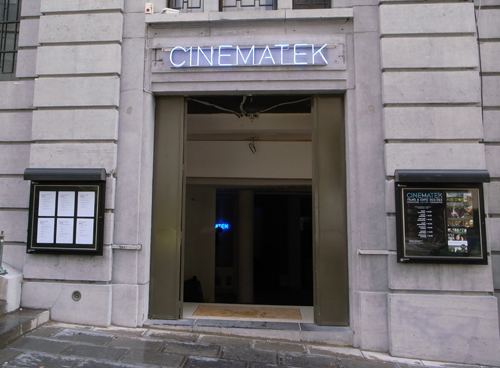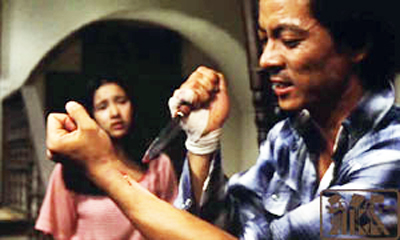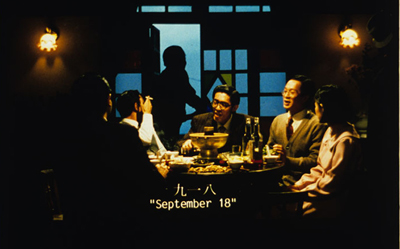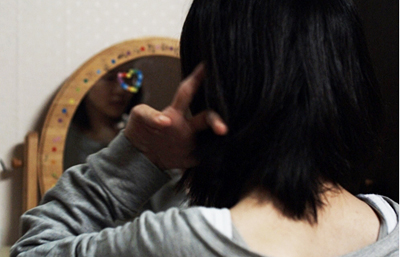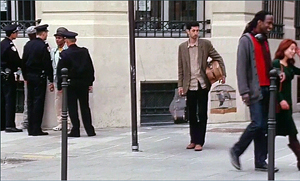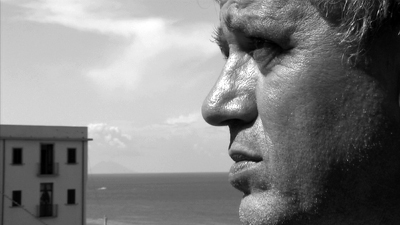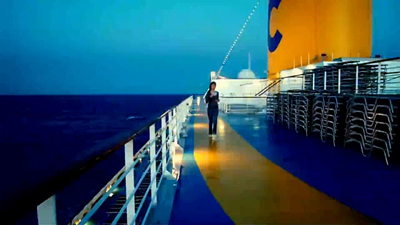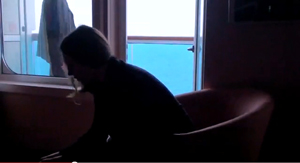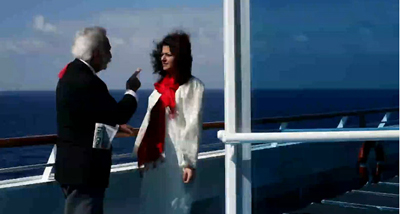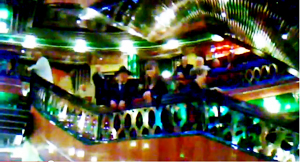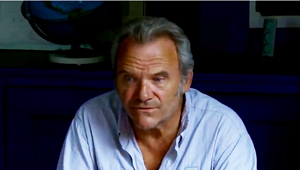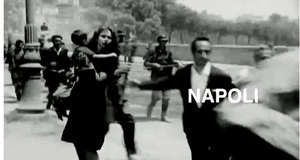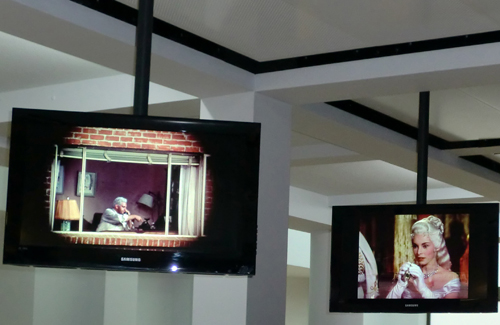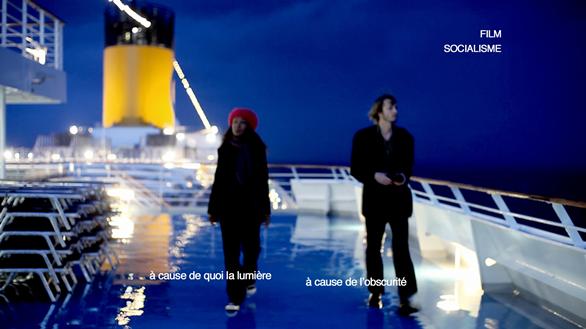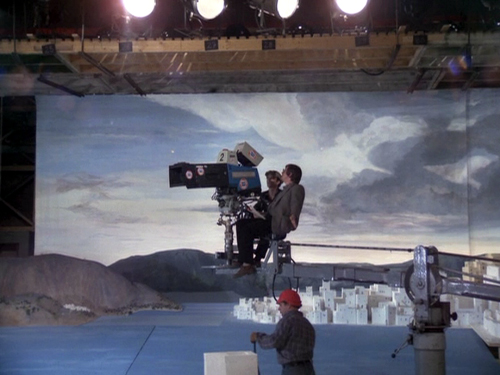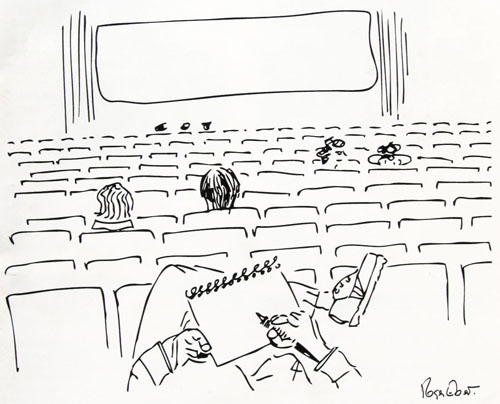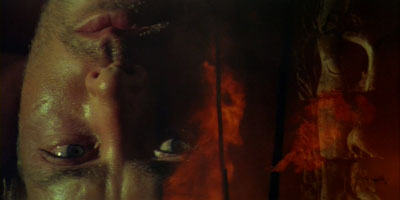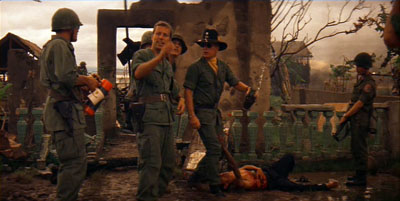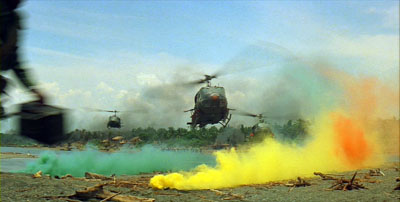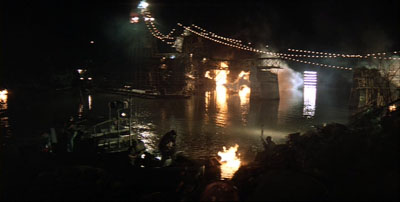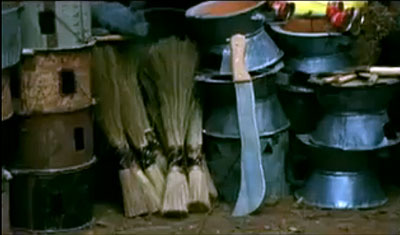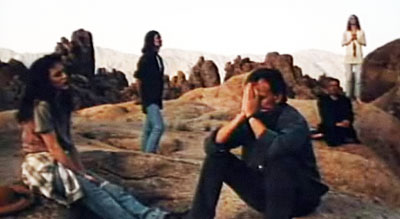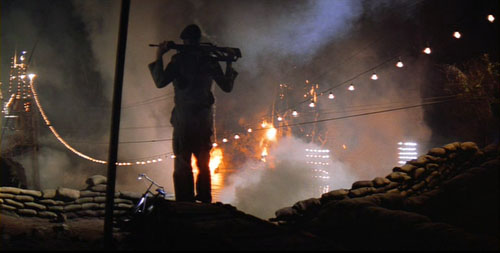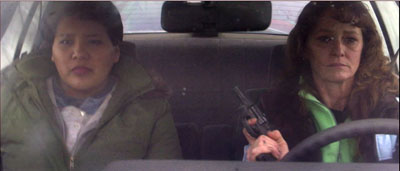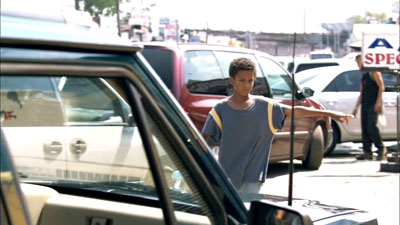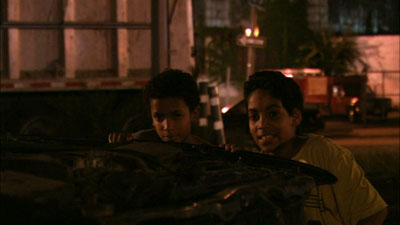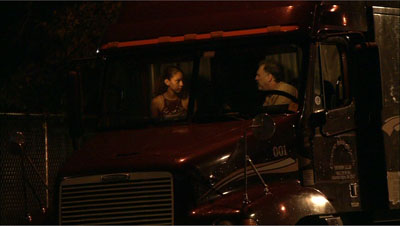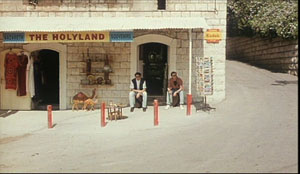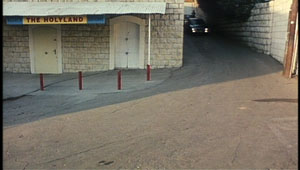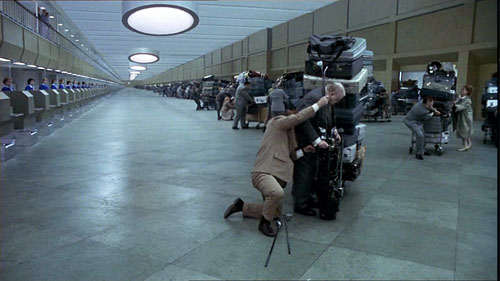Archive for the 'Art cinema' Category
Ledoux’s legacy
DB here:
Every summer Brussels hosts one of the world’s most unusual film festivals. By global standards it’s a small event: it showcases only twenty or so titles, each screened twice. The films are on the whole unknown. The prizes are minuscule by the million-plus benchmarks set by Dubai and Abu Dhabi. The venue stands behind an inconspicuous doorway. Yet for me it’s an unmissable event, a crucial influence on my thinking about film and my search for cinematic satisfaction.
Jacques the gentle
Young Murderer (Seishun no satsujin sha, 1976).
Between 1948 and his death in 1988, Jacques Ledoux was the curator of the Royal Film Archive of Belgium. He made it into one of the cinema’s legendary places, at once Mecca and Aladdin’s cave. On remarkably small budgets, he assembled broad and deep collections. He bought many titles for distribution to local cinemas and schools. He created a public screening program that for decades has shown five different films (two of them silents), every day of the year. The year Ledoux died he received an Erasmus Prize for his services to European culture.
His early life could have come out of an East European movie. Born in Poland in 1921, he fled to Belgium to escape the German onslaught. He hid in several places, including a monastery. There the abbot gave him work publishing Benedictine books. In the abbey’s screening room Ledoux discovered a copy of Nanook of the North. He offered it to the just-started Belgian Cinémathèque, and its supervisor, the filmmaker Henri Storck, offered Ledoux a job. Finding film archivery more appealing than studying science and medicine, he stayed with the Cinémathèque. Interestingly, “Jacques Ledoux” was a pseudonym; one translation is Jacques the Gentle.
Not always gentle Jacques in his scraps with other archivists and local politicians, Ledoux pledged himself to filmmakers, audiences, and—a rarity at the time—overseas film scholars. New Wave directors and Parisian critics made railway pilgrimages to Brussels to see films unavailable in France. When Kristin and I started doing research in the archive in the 1979, Ledoux welcomed us and guided us to treasures we hadn’t known existed.
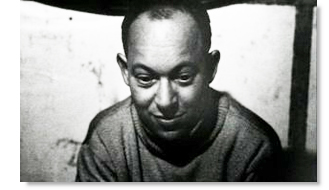 Unlike the very public Henri Langlois, Ledoux worked best behind the scenes. Probably most cinephiles today know him only from his brief appearance as one of the sinister experimentalists in La Jetée (1961). He resisted being photographed, and he refused to wear a necktie. Unsurprisingly, he admired directors who strayed from the beaten path. He created the first festival of experimental cinema at Knokke-le-Zoute, in 1949.
Unlike the very public Henri Langlois, Ledoux worked best behind the scenes. Probably most cinephiles today know him only from his brief appearance as one of the sinister experimentalists in La Jetée (1961). He resisted being photographed, and he refused to wear a necktie. Unsurprisingly, he admired directors who strayed from the beaten path. He created the first festival of experimental cinema at Knokke-le-Zoute, in 1949.
His desire to widen everyone’s knowledge of cinema found another outlet when he created the Prix l’Age d’or/ Prijs l’Age d’or in 1958. It was aimed to reward, as Ledoux put it, “a film that, by questioning taken-for-granted values, recalls the revolutionary and poetic film of Luis Buñuel, L’Age d’or.” Ledoux wanted to encourage a cinema that was subversive in both content and form.
The first prizes were given within the framework of the Knokke event: in 1958, to Kenneth Anger; in 1963, to Claes Oldenberg; in 1967 to Martin Scorsese (for The Big Shave). In 1973, the prize assumed something close to its current form. Several films were screened for the public, and the award, now in the form of cash, was decided by a jury system. The first winners were W. R.: Mysteries of the Organism (in 1973); Borowczyk’s Immoral Tales (1974); Raul Ruiz’s Expropriation (1975); Angelopoulos’ Traveling Players (1976); Hasegawa Kazuhiko’s Young Murderer (1977); and Antoni Padros’ Shirley Temple Story (1978).
The winners emerged from a vast and powerful field of competition. In 1973, the first formal year of L’Age d’or, there were sixty-nine films screened, including Aguirre, the Wrath of God, Oshima’s Ceremonies, Paul Morrissey’s Heat, Tout va bien, and works by Rosa von Praunheim, Wim Wenders, and Miklós Jancsó. There was even The Discreet Charm of the Bourgeoisie, but Buñuel didn’t win a prize named after his own film! The number of titles dropped a little as the years passed, but it’s good to know that in 1978 Assault on Precinct 13, Eraserhead, Perceval le Gallois, and films by Ruiz, Littín, and Schroeter were in the competition.
Ciné-Discoveries
City of Sadness (Hou Hsiao-hsien, 1989); screened at Cinedécouvertes 1990.
Things changed a bit after 1979. The L’Age d’or criteria were modified to identify “films that by their originality, the singularity of their viewpoint, and their style [ecriture] deliberately break from cinematic conformity.” For whatever reasons, hard-edged subversive cinema was harder to come by. In the meantime, the Prix was absorbed into a broader festival Ledoux launched in 1979, Cinédécouvertes.
Cinédécouvertes became a “festival of festivals.” It culled its selection from films that had been screened at Rotterdam, Berlin, Cannes, Venice, and other events. What set Cinédécouvertes apart was its determination to expand film culture. All the films on the program had no Belgian distribution. Each cash award (today, two of 10,000 euros each) would go not to the filmmaker but to a distributor willing to pick up the film. This is a very tangible way to help films of quality find a local audience.
Over the last ten years, Cinédécouvertes has awarded prizes to Audition, Chunhyang, Werckmeister Harmonies, Oasis, Tropical Malady, Day Night Day Night, Mogari no Mori, Afterschool, and Police, Adjective. The L’Age d’or prize has been given to Aoyama’s Eureka, Reygadas’ Japón, Encina’s Hamaca Paraguay, Balabanov’s Cargo 200, and several others. Not every film has been picked up for local distribution, but the impulse to elevate films that go beyond the obvious festival favorites has continued. Ledoux’s successor as curator, Gabrielle Claes, has maintained the legacy of L’Age d’or and Cinédécouvertes. The July festival flourishes in the Cinematek’s newly rebuilt complex and in its other venue, the lovely postwar-moderne building in the Flagey neighborhood.
The annual Brussels event helped me find my way through modern cinema. There I saw my first Kiarostami (Where is My Friend’s Home?), my first Tarr (Perdition), my first Hou (Summer at Grandpa’s), my first Oliveira (No; or, the Vainglory of the Commander), my first Sokurov (The Second Circle), my first Kore-eda (Maborosi), my first Panahi (The Mirror), my first Jia (Xiao Wu). The Cinematek’s talent-spotters were quick to find many of the most important filmmakers of the 1980s and 1990s, and I’ll be forever grateful for their acumen. After I saw these films and many others here, my ideas about cinema got more cogent and complicated. My life got better, too.
Now most of these filmmakers find commercial distribution in Belgium, so Gabrielle’s scouts must scan new horizons. This year as usual Cinédécouvertes boasted some familiar names like Iosseliani, Wiseman, Guzman, and the eternal troublemaker Godard. But there are also filmmakers from Costa Rica, Sri Lanka, Ireland, Peru, Colombia, and Ukraine. The landscape of film is vast, as Ledoux always reminded us, and a small festival can nonetheless open windows wide.
Mind games, or just games
Elbowroom.
Psychology is at the center of festival cinema. Deprived of car chases and exploding buildings, arthouse filmmakers try to track elusive feelings and confused states of mind. That this can be dramatically engaging in quite a traditional way, as was shown by one of the Cinédécouvertes winners, How I Ended This Summer.
Director Aleksei Popogrebsky puts two men on a desolately beautiful island in the Arctic. They’re initially characterized by the way they execute the routines of measuring weather conditions. Sergei, the stolid older one, is soaked in the ambience of the place, enjoying fishing and boating while insisting on exactness in the log. Pasha is a summer intern, a little careless because he’s exhilarated by the atmosphere: he’s introduced first taking a Geiger-counter reading but then hopping and racing along a cliff edge to the beat of his iPod.
Soon, though, Pasha must give Sergei a piece of bad news that comes in over the radio. Out of awkwardness, fear, refusal of responsibility, and other impulses, he avoids telling his mentor. The consequences are unhappy for each. The film takes on the suspense of a thriller, with conflicts surfacing in a cat-and-mouse game at the climax. Yet before that, more subtly, we have watched several tense long takes of Pasha’s face as he tries to cover up his failures. Not surprisingly, How I Ended This Summer won one of the two Cinédécouvertes prizes. It is an engrossing case for character-driven, locale-sensitive cinema.
Elbowroom tackles psychology from a more opaque and disturbing angle. With no exposition or backstory, we’re plunged into an institution for the handicapped. During the first ten minutes, without dialogue, a handheld camera lurks over the shoulder of a young woman who tries with twisted fingers to apply lipstick. Soon she is preparing to have sex with another inmate, and after their liaison she is whacking her feeble roommates, who sob under her blows. Eventually we’ll recognize this introduction as a summary of her days: fighting with others, being coaxed or berated by staff, meeting her lover, and taking up cleaning tasks. Only far into the film will we learn about how she got here and what her fate will be.
Soohee, stricken with cerebral palsy, is played by a young woman with a milder disease. Very often the camera doesn’t let us see her face, fastening instead on a ¾ view from behind. This seems to me partly a matter of tact, but its ultimate effect is to force us to infer Soohee’s state of mind from her behavior. The visual narration remains resolutely outside the character. Psychology gets reduced to gestures— spasmodic smearing of lipstick, the clasping of a necklace, the seizure of a baby doll (with which she’s bribed). Only at the end does a long held close-up of Soohee’s twitching, smiling face give us fairly direct access to her feelings. Despite the smile—which can be read as a sort of perverse victory for her—Soohee isn’t the noble victim; we’ve seen her petty and selfish side already.
This trip into a world most of us haven’t seen before is presented without conventional pieties, and it’s unsettling. Elbowroom, Ham Kyoung-Rock’s first feature, offers the sort of challenge to aesthetic and moral conventions that the L’Age d’or Prize was designed to encourage. The film won it.
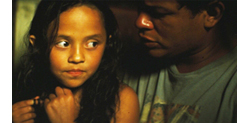 Characters’ psychological developments can also be brought out by parallel construction. A willful little girl and a scientist cross paths in Paz Fábrega’s Cold Water of the Sea. Karina is on a beach holiday with her family and insists on wandering off at intervals. Marianne is a medical researcher, here for a vacation with her boyfriend. When Marianne finds Karina asleep along the road one night, the girl claims that her parents are dead and that her uncle abuses her. But next morning she’s gone, and fears for her safety are only the first of several anxieties that haunt Marianne’s holiday. While Karina incessantly bedevils her mother and makes mischief with other kids, Marianne descends into ennui as she watches her boyfriend devote his time to selling a piece of family property.
Characters’ psychological developments can also be brought out by parallel construction. A willful little girl and a scientist cross paths in Paz Fábrega’s Cold Water of the Sea. Karina is on a beach holiday with her family and insists on wandering off at intervals. Marianne is a medical researcher, here for a vacation with her boyfriend. When Marianne finds Karina asleep along the road one night, the girl claims that her parents are dead and that her uncle abuses her. But next morning she’s gone, and fears for her safety are only the first of several anxieties that haunt Marianne’s holiday. While Karina incessantly bedevils her mother and makes mischief with other kids, Marianne descends into ennui as she watches her boyfriend devote his time to selling a piece of family property.
Once more Rossellini’s Voyage to Italy proves to be a template for festival cinema. What is wrong with Marianne goes beyond her diabetes: she feels bored and useless. But while Rossellini adhered primarily to the viewpoints of his dissolving couple, Fabrega opens out the portrayal of upper-class anomie by intercutting episodes from the lives of working-class families. The film has two fully-developed protagonists, with Karina’s verve balancing Marianne’s increasing torper. Splitting his story allows Fabrega to make some social points (the family camps on the beach, the couple stays in a motel with a scummed-over swimming pool) and to suggest secret affinities between the little girl and the professional woman. Cold Water of the Sea seemed to me an honorable effort to let some air into the premises of the standard portrayal of a cosmopolitan couple’s ennui.
Parallels likewise form the core of Otar Iosseliani’s Chantrapas, another of his celebrations of shirkers, layabouts, con artists, and free spirits. The title is Russian slang for a disreputable outsider (derived from the French ne chantera pas, “won’t sing”). Here the outsider is Kolya, a young Georgian director who turns in a movie that can’t pass the censors. He emigrates to Paris, where he finds an aging producer (played by Pierre Etaix) eager to tap his talent. But the new project’s backers try to take over the project in scenes deliberately echoing the ones of Party interference.
Chantrapas lacks the shaggy intricacy of Iosseliani’s “network narratives” like Chasing Butterflies (1992) and Favorites of the Moon (1984), the latter of which I enjoyed analyzing in Poetics of Cinema. When we’re given a single protagonist, as in Monday Morning (2002), Iosseliani’s characteristic refusal of motivation, exposition, and introspection creates a more plodding pace. No mind games here. In earlier films, his favorite shot—panning to follow people walking—creates convergences and near-misses and comic comparisons in the vein of Tati. Here the pans serve as merely functional devices, almost time-fillers, and comedy is largely lacking. Still, Iosseliani avoids the easy traps. A Soviet censor bans Kolya’s film, then congratulates him on making such a good movie. When the Parisian preview audience flees the theatre, we can’t call them philistines. Kolya’s movie, despite its stylistic debt to Iosseliani’s own films, looks awful. In the end, even cinema seems less important than smoking, drinking, eating, and, above all, loafing.
It was a documentary, Nostalgia de la Luz by Patricio Guzmán, that won the second Cinédécouvertes prize. It starts as a memoir of Guzmán’s fascination with astronomy, explaining that the unusually clear skies of Chile have attracted researchers who want to probe the cosmos. Because the light from heavenly bodies takes a long time to reach us, Guzmán casts his observers as archeologists and historians: “The past is the astronomer’s main tool.” This is the pivot to the film’s main subject, the search for the disappeared under the US-installed dictator Pinochet.
The analogies rush over us. The enormity of the universe is paralleled by the immensity of Pinochet’s oppression of his country. Captives in desert concentration camps learned astronomy, but eventually they were forced inside at night; the skies’ hint of freedom threatened the regime. Some of the astronomers are friends or relations of the disappeared and see research as therapeutic, putting their personal sufferings in a much more vast cycle of change. Above all there are the old women who patiently scour the desert for traces of their loved ones. A woman tells of finding her brother’s foot, still encased in sock and shoe. “I spent all morning with my brother’s foot. We were reunited.” Scientists try to know the history of the cosmos, and ordinary people tirelessly challenge their government’s efforts to conceal crimes. Both groups, Guzmán suggests, acquire nobility through their respect for the past.
Taking some chances
More formally daring was Totó. This was the first Peter Schreiner film I’ve seen, and on the basis of this I’d say his high reputation as a documentarist is well-deserved. Without benefit of voice-over explanations, we follow Totó from his day job at the Vienna Concert Hall (is he a guard or usher?) to his hometown in Calabria. The film is an impressionistic flow registering his musings, his train travel, and his conversations with old friends, many of the items juggled out of chronological order.
Schreiner avoids the usual cinéma-vérité approach to shooting. Instead the camera is locked down, the framing is often cropped unexpectedly, and the digital video supplies close-ups that recall Yousuf Karsh in their clinical detail. We see pores, nose hair, follicles at the hairline; the seams of sagging eyelids tremble like paramecia. In addition—though I won’t swear that Schreiner controlled this—the subtitles hop about the frame, sometimes centered, sometimes tucked into a corner of the shot, usually with the purpose of never covering the gigantic mouths of the people speaking. All in all, a documentary that balances its human story with an almost surgical curiosity about the faces of its subjects. The Jean Epstein of Finis Terrae would, I think, admire Totó.
I had to miss some of the offerings, notably Oliveira’s Strange Case of Angelica. (Fingers crossed that it shows up in Vancouver.) Eugène Green’s Portuguese Nun was screened, but I’ve already mentioned it on this site. Other things I saw didn’t arouse my passion or my thinking, so they go unmentioned here. Of the remainders, two stood out above the rest for me.
My Joy (Schastye moe), by Sergei Loznitsa, is a daring piece of work. After a harsh prologue, it spends the first hour or so on Georgy, a trucker whose effort to make a simple delivery takes him into the predatory world of the new Eastern Europe. He meets corrupt cops, a teenage hooker, and most dangerously a trio of ragged men bent on stealing his load. After an anticlimactic confrontation, the film introduces a fresh cast of characters, including a mysterious Dostoevskian seer. The film becomes steadily more despairing, culminating in a shocking burst of violence at a roadside checkpoint.
At moments, My Joy flirts with the idea of network narrative. When Georgy turns away from a traffic snarl, the camera dwells on roadside hookers long enough to make you think that they will now become protagonists. One character does bind the stories together: an old man who fought in World War II and who now helps the seer at a moment of crisis. The sidelong digressions, slightly larger-than-life situations, and the floating time periods suggest a sort of Eastern European magic realism. But the whole is intensely realized, at once fascinating and dreadful. After one viewing, I wanted to see it again.
My favorite, as you might expect, was Godard’s Film Socialisme. There are the usual moments of self-conscious cuteness (the zoom to the cover of Balzac’s Lost Illusions, for instance), but on the whole it’s pretty splendid.
Contrary to what a lot of people claim, I don’t think Godard is an “essayist” in most of his films. (Perhaps in Histoire(s) du cinema, but rarely elsewhere.) He tells stories. Granted, they are elliptical, fragmentary, occulted stories, free of expository background and flagrantly unrealistic in their unfolding. Into these stories he inserts citations, interruptions, digressions: associational form gnaws away at narrative. But stories they remain.
The first part of Film Socialisme takes place on a cruise ship. As it visits various ports on the Mediterannean, some passengers learn that a likely war criminal is on board. Then, like Loznitsa, Godard shifts to a new plot. In the French countryside, a garage-owner’s family is invaded by a TV crew. (As far as I can tell from the untranslated dialogue, the son and daughter are purportedly running for elective office.) Finally, in the last eighteen minutes or so, we get pure associational cinema—not an essay, I think, but something like a collage-poem: a busy montage of clips seeking (or so it seems to me) to ask what sort of European politics is possible after the death of socialism.
Andréa Picard has already written a superb commentary on the film, and it would be useless for me, after only two viewings, to try to go much beyond her account. I’d just say that the first two stories show the same sort of ripe visual imagination we have come to expect from late Godard. The images are oblique and opaque, framed precisely but denying us much in the way of story information. Who are these people? Who’s related to whom? (Who are the women apparently linked with the mysterious Goldberg?) More concretely, who’s talking to whom?
Godard cuts among images of varying degrees of definition in a manner reminiscent of Eloge de l’amour, but here color is paramount. We get saturated blocks of blue sky and blue/ turquoise/ charcoal sea. See the image further above, or this one, which is virtually a perceptual experiment on the ways that color changes with light and texture.
Anybody with eyes in their head should recognize that such shots show what light, shape, and color can accomplish without aid of CGI. They aren’t simply pretty; they’re gorgeous in a unique way. No other filmmaker I know can achieve images like them. We also get entrancing scatters of light in low-rez shots in the ship’s central areas and discotheque.
Just as noteworthy from my front-row seat was Godard’s almost Protestant severity in sound mixing. For the first twenty minutes or so, the sound is segregated on the extreme right and extreme left tracks, leaving nothing for the center channel. We hear music on the left channel and sound effects on the right, or ambient sound on one side and dialogue on the other. The result is a strange displacement: characters centered in the screen have their dialogue issuing from a side channel. Sometimes a sound will drift from one channel to another and back again, but not in a way motivated by character movement (“sound panning”). Having accustomed us to this schizophrenic non-mix, Godard then starts dropping a few bits into the center channel. But for the bulk of the shipboard story, that region is largely unused.
We leave the ship with a title, “Quo Vadis Europa,” and now we’re in Martin’s garage, listening to him being interviewed by an offscreen woman. His voice squarely occupies the central channel, with offscreen traffic sliding around the side channels. The same central zone is assigned to the wife and the kids. Would it be too much to say that the working people have taken control of the soundtrack? In any case, although the side channels are very active, the sound remains centered during a permutational cluster of family scenes (parents and children alone, father with daughter, mother with son, boy with father, daughter with mother).
This section ends with a final confrontation with the nosy reporters. The overall episode can be seen as a revisiting of Numero deux (1975), another uneasy family romance and one of Godard’s first forays into video.
The rapid-fire finale would require the sort of parsing that Histoire(s) du cinema has invited. Through footage swiped from many other filmmakers, Godard revisits the cruise ship’s ports of call, investing each with a symbolic role in the history of the West. Egypt and Greece get considerable emphasis, but so do Palestine and Israel. This history is, naturally, filtered through cinema: not just footage of the Spanish Civil War but clips from fiction films like The Four Days of Naples (1962). After glimpses of Eisenstein’s Odessa Steps massacre, we get shots of today’s kids standing on the steps declaring they have never heard of Battleship Potemkin.
Exasperating and exhilarating, Film Socialisme shows no flagging of its maker’s vision. “He’s a poet who thinks he’s a philosopher,” a friend remarked. Or perhaps he’s a filmmaker who thinks he’s a painter and composer. In any case, Film Socialisme will be remembered long after most films of 2010 have been forgotten. More intransigent than most of his other late features, and unlikely to be distributed theatrically outside France, if there, it shows why we need “little” festivals like Cinédécouvertes now more than ever.
The home page of the Cinematek is here. A complete list of L’Age d’or and Cinédécouvertes winners is here. Last year, between research and preparing for Summer Movie Camp, I had no time to blog about the festival. But you can go to my earlier coverage for 2007 and 2008.
As one who cares about Godard’s aspect ratios, it pains me to use illustrations from online sources, which are notably wider than the version I saw projected in Brussels. When I can get my hands on a proper DVD version, I will replace these images with ones of the right proportions.
Seeing movie seeing: Display monitors in the reception area of the Cinematek.
It takes all kinds
Kristin here—
How many directors are there whose bad reviews just make you more eager to see their new films? I’m not at Cannes and haven’t seen Jean-Luc Godard’s Film socialisme. But I’ve read some negative reviews, mainly those by Roger Ebert and Todd McCarthy. Now I’m really hoping that Film socialisme shows up at the Vancouver International Film Festival this year. (Please, Mr. Franey? I promise to blog about it.)
As you can tell from my writings, I’m no pointy-headed intellectual who won’t watch anything without subtitles. I love much of Godard’s work and have analyzed two films from early in what a lot of people see as his late, obscurantist period (Tout va bien and Sauve qui peut (la vie) in Breaking the Glass Armor). But I also love popular cinema. If I made a top-ten-films list for 1982, both Mad Max II (aka The Road Warrior) and Passion (left and below) would be on it.
Of course, those are old films by most people’s standards. Godard’s films have gotten much more opaque since I wrote those essays. I wouldn’t dare to write about King Lear or Hélas pour moi. That’s partly because I don’t speak French, though a French friend of ours has assured us that that doesn’t help much. Here Godard thwarts the non-French-speaker further by not translating the dialogue. Variety‘s Jordan Mintzer describes the subtitles that appear in the film: “To add fuel to the fire, the English subtitles of “Film Socialism” do not perform their normal duties: Rather than translating the dialogue, they’re works of art in themselves, truncating or abstracting what’s spoken onscreen into the helmer’s infamous word assemblies (for example, “Do you want my opinion?” becomes “Aids Tools,” while a discussion about history and race is transformed into “German Jew Black”).” Mintzer’s review provides a long description of the film; he mentions how baffling it is but doesn’t offer any real value judgments on it. Like other reviews, though, it piques my interest in the film.
Since Godard has increasingly moved into video essays, I’ve not kept as close track of him. But I always look forward to seeing his occasional new features on the big screen. The man has a mysterious knack for making beautiful images out of the mundane. How could a shot of a distant airplane leaving a jet-trail across a blue sky be dramatic? Godard manages it in the first shot of Passion. (I won’t show a frame from that shot, since it depends on the passage of time for its effect.) His soundtracks are dense and playful. Every few years the man cobbles together an incomprehensible plot based on rather tired political ideas and turns out something so visually striking that it might as well be an experimental film. I’m willing to watch and listen hard without assuming that I’m obliged to strain to find a message. McCarthy comments, “More personally, I have become increasingly convinced that this is not a man whose views on anything do I want to take seriously. […]” Did we take his views all that seriously back when he was a Maoist? I didn’t, but La Chinoise is a terrific film.
That’s not my point, though. As Ebert’s and McCarthy’s reviews both mention there are devotees of Godard who will most likely enjoy and defend Film socialisme. Ebert: “I have not the slightest doubt it will all be explained by some of his defenders, or should I say disciples.” McCarthy says that Godard is one of an “ivory tower group whose work regularly turns up at festivals, is received with enthusiasm by the usual suspects and then is promptly ignored by everyone other than an easily identifiable inner circle of European and American acolytes.” (McCarthy’s review is entitled “Band of Insiders.”)
I’m not sure what’s wrong with being devoted to Godard, even to the point of defending films that may be obscure or even maddening. I personally haven’t enjoyed his more recent theatrical releases like Forever Mozart and Éloge pour l’amour as much as his earlier work, but they’re still better than most Hollywood, independent, and foreign art-house films. The man is pushing 80 and not likely to change, so live and let us acolytes live.
Not coming to a theater remotely near you
I’m not here to defend Godard—not yet, anyway. But on May 19, Roger posted an essay calling for more “Real Movies” to be made, essentially narratives based on psychologically intriguing characters in situations with which we can empathize. He doesn’t say so, but I suspect this idea was inspired in part by his reaction to Film socialisme. His examples of real movies are some of the films he’s enjoyed this year at Cannes. I haven’t seen those, either, but I’ve read enough of Roger’s writings and been to Ebertfest often enough to know he loves U. S. indie films like Frozen River and Goodbye Solo. Excellent films with fascinating characters, but they and most of the foreign-language films that get released in the U.S. play mostly at festivals and in art-houses, both of which tend to be confined to cities and college towns. I’m sure that such character-driven films would be more likely than Film socialisme to get booked into art-houses, but they wouldn’t wean Hollywood from its tentpole ways.
Even the films that play festivals and arouse great emotion and admiration in the audiences will seldom break through into the mainstream. There simply aren’t enough of those art-houses.
As with many of Roger’s posts, “A Campaign for Real Movies” has aroused comments from people complaining about the lack of an art-house within driving distance of where they live. Jeremy Chapman remarked:
But Roger, if they did that (“Real Movies”), then I’d return to the cinema. And those in charge of the movie industry have proven again and again that they don’t wish to see me there. They’d rather show regurgitated nonsense to people so desperate for some distraction from their lives that they’ll go even though they know that they’re watching rubbish.
If any of these films you mention play nearby, then I shall see them. But they won’t. Instead I’ll have the option of Avatar II or some remake of a movie that was quite good enough (or not) the first time it was made. I love the movies, but I’m so over the movie industry (at least in the US).
Talking to regulars at Ebertfest, one hears time and again that some of them journey across several states to have a quick, intense immersion in films that haven’t played near their homes. Similarly, many who post comments on Roger’s essays refer to having been limited to seeing indie and foreign films on DVDs or downloads from Netflix.
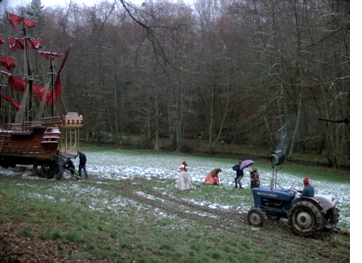 I completely sympathize with that problem. Even with Sundance’s six-screen multiplex and the University of Wisconsin’s Cinematheque series and Wisconsin Film Festival, most of the movies David and I see at events like Vancouver or Hong Kong don’t play here. Sundance has to book pop films on some of its screens to allow them to bring art films to the others. Right now Iron Man 2 and Sex in the City 2 are playing there, alongside The Secret in Their Eyes and Letters to Juliet. If that’s what it takes to keep the place going, then so be it.
I completely sympathize with that problem. Even with Sundance’s six-screen multiplex and the University of Wisconsin’s Cinematheque series and Wisconsin Film Festival, most of the movies David and I see at events like Vancouver or Hong Kong don’t play here. Sundance has to book pop films on some of its screens to allow them to bring art films to the others. Right now Iron Man 2 and Sex in the City 2 are playing there, alongside The Secret in Their Eyes and Letters to Juliet. If that’s what it takes to keep the place going, then so be it.
However much people decry the crassness of Hollywood—and there’s plenty of it to go around—or denounce audiences who only go to the latest CGI spectacle, the simple fact is that the market rules. Indeed, if there were a truly free market, we probably would see far fewer indie and foreign-language films. Film festivals are supported largely by sponsors, and the films they show are often wholly or partially subsidized by national governments. The festival circuit has long since become the primary market for a range of films that otherwise never reach audiences.
That may sound terrible to some, but consider the other arts. Some presses only publish books they hope will be best-sellers, while poetry and other specialist literature is relegated to small presses whose output doesn’t show up in Barnes & Noble. That’s very unlikely to change. Amazon and other online sales have been a shot in the arm for small presses, just as Netflix has made it far easier for people to see films they probably would not otherwise have access to. (Our plumber told me the other day that he had been watching a bunch of recent German films downloaded from Netflix. Well, that’s Madison, as we say; high educational level per capita. But most people have the same option, if they wish.)
Art-houses are scarce in small cities and towns, but such places are not likely to have opera houses either, or galleries with shows of major modern artists, or bookstores which offer 125,000 titles. (As I recall, that’s what Borders claimed to have when it first opened in Madison. Now they seem to be working on that many varieties of coffee.) Opera or ballet lovers are used to traveling to cities where they can see productions, and serious Wagner buffs aim to make the pilgrimage to Bayreuth at least once in their lives.
David and I are lucky. It’s vital to our work to keep up on world cinema, so now and then we travel to festivals and wallow in movies for a week or two. Quite a few civilians plan their vacations around such events, too. We’ve run into people in Vancouver who say they save up days off and take them during the festival. Naturally not everyone can do that, but not everybody can see the current Matisse exhibition in Chicago (closes June 20) or the recent lauded production of Shostakovich’s eccentric opera The Nose at the Metropolitan. I really wish I had seen The Nose, but I don’t really expect the production to play the Overture Center here.
To some people, film festivals might sound like rare events that inevitably take place far away, like the south of France. Those are the festivals that lure in the stars and get widespread coverage. But there are thousands of lesser-known festivals around the world, dedicated to every genre and length and nationality of cinema. For those who like to see old movies on the big screen, Italy offers two such festivals, Le Giornate del Cinema Muto (silent cinema) and Il Cinema Ritrovato (restored prints and retrospectives from nearly the entire span of cinema history; this year’s schedule should be posted soon). Last month in Los Angeles, Turner Classic Movies successfully launched its own festival of, yes, the classics. Ebertfest itself began with the laudable goal of bringing undeservedly overlooked films to small-city audiences, specifically Urbana-Champaign, Illinois. It was and is a great idea, and it would be wonderful if more towns in “fly-over country” had such festivals.
The films we don’t see
Usually when someone calls for more support of independent or foreign films, there seems to be an implicit assumption that all those films are deserving of support, invariably more so than Hollywood crowd-pleasers. If a filmmaker wants to make a film, he or she should be able to, right? But proportionately, there must be as many bad indie films as bad Hollywood films. Maybe more, because there are always lots of first-time filmmakers willing to max out their credit cards or put pressure on friends and relatives to “invest” in their project. There’s also far less of a barrier to entry, especially in the age of DYI technology.
True, the indie films we see seem better. By the time most of us see an indie film in an art cinema, it has been through a pitiless winnowing process. Sundance and other festivals reject all but a relatively small number of submitted films. A small number of those get picked up by a significant distributor. A small number of those are successful enough in the New York and LA markets to get booked into the art-house circuit and reach places like Madison. Yes, some worthy films get far less exposure than they deserve. But many more films that would give indies a bad name mercifully get relegated to direct-to-DVD, late-night cable, or worse. On the other hand, most mainstream films, no matter how dire their quality, get released to theaters. Their budgets are just too big to allow their producers to quietly slip them into the vault and forget about them.
The winnowing process for art-house fare happens on an international level as well. A prestige festival like Cannes dictates that a film they show cannot have had a festival screening or theatrical release outside its country of origin. Programmers for other festivals come to Cannes and cherry-pick the films they like for their own festivals. Toronto has come to serve a similar purpose, especially for North American festivals. Some films fall by the wayside, but the good ones attract a lot of programmers. These films show up at just about every festival. By the way, that kind of saturation booking of the year’s art-cinema favorites at many festivals means that the distributors are more and more often supplying digital copies of films to the second-tier events. Going to festivals is no longer a guarantee that you’ll be seeing a 35mm print projected in optimal conditions. At the 2009 Vancouver festival, I watched Elia Suleiman’s The Time that Remains twice, because it was a good 35mm print and I suspected that I’d never have another chance to see it that way.
To each film its proper venue
There’s no way that every deserving film will reach everyone who might admire it. Condemning the crowds who frequent the blockbusters won’t help open new screens to offbeat fare. If someone loves Avatar, as long as they keep their cell phones off, refrain from talking, and don’t rustle their candy-wrappers too loudly, as far I’m concerned they can go on believing that this is the best the cinema has to offer. Simply showing these audiences a film like A Serious Man, say, or Precious isn’t going to change their minds about what sort of cinema they prefer. To break through decades of viewing habits, such people would need to learn new ones, which takes time and effort. People’s tastes can be educated, but the odds are usually against it actually happening.
Finally, in defending art cinema against mainstream multiplex fare, commentators often cite Avatar or Transformers or the latest example of Hollywood’s venality and audience’s herd-like movie-going patterns. Yet every year major studio films come out that get four stars or thumbs up or green tomatoes. Last year, we had Cloudy with a Chance of Meatballs, Up, Inglourious Basterds, Coraline, and a few others that were well worth the price of a ticket. All of them did fairly well at the box-office while playing in multiplexes. Some readers might substitute other titles for the ones I’ve mentioned, but to deny that Hollywood is bringing us anything worth watching seems blinkered. As I said in 1999 at the end of Storytelling in the New Hollywood, where I criticized some aspects of recent filmmaking practices, “In recent years, more than ever, we need good cinema wherever we find it, and Hollywood continues to be one of its main sources.”
Ultimately my point is that in this stage in cinema history, international filmmaking has settled into a defined group of levels or modes. Hollywood gives us multiplex blockbusters and more modest genre items like horror films and comedies. They bring us the animated features that are among the gems of any year’s releases. Then there are the independent films and the foreign-language ones which together form festival/art-house fare. There are also the experimental films, which play in festivals and museums. The institutions that show all these sorts of films have similarly gelled into specialized kinds of venues suited to each type. A broad range of films is still being made. There are some few really good films in each category made each year. The question is not how many worthy films are getting made but how much trouble it takes to see them.
None of the current types of institutions is likely to change on its own. What will make a difference is the growing possibilities of distribution via the internet. Filmmakers who get turned down by film festivals can produce, promote, and sell their movies via DVD or downloads. True, recouping expenses that way is so far a dubious proposition; it’s probably easier to get into Sundance than to do that. As I mentioned, digital projection may make some festivals less attractive to die-hard film-on-film cinephiles. On the other hand, in some towns opera-lovers who can’t get to the big city now can see a digital broadcast of a major production each week at their local multiplex. Not as exciting as a trip to the city to see it live, but a lot cheaper and hence within the reach of a lot more people’s means. All sorts of other digital developments will change movie viewing in ways we can’t yet imagine.
_______________
Jim Emerson has been covering the Film socialisme battle of the reviews on Scanners, with quotes and links to the ones I mentioned and more. He also demonstrates that people have been baffled by Godard since Breathless, with reviews that “are, incredibly, the same ones he’s been getting his entire career — based in part on assumptions that Godard means to communicate something but is either too damned perverse or inept to do so. Instead, the guy keeps making making these crazy, confounded, chopped-up, mixed-up, indecipherable movies! Possibly just to torture us.” He offers as evidence quotes from New York Times reviews over the decades.
Eric Kohn gauges the controversy and offers a tentative defense of the film on indieWIRE.
For our reports on various festivals, see the categories on the right. We discuss Godard’s compositions, late and early, here and his cutting here.
Festival as repertory
DB here:
This picture points backward and forward. It looks back to the days when movies were shown on a big screen to hundreds of people in real time. No pausing or fast forwarding; you take what you get. Some viewers are settled in pretty close to the screen, and a few dare to sit in the front row. (Save me the center seat, fortunately still vacant.) The critic sits slumped far back, implying coolly distant appraisal. The pen is poised to note down moments of power, beauty, or stupidity.
But the big auditorium is nearly empty, and this makes the drawing foreshadow the approaching end of moviegoing. The warning signs are emerging: Visit any movie, even an Imax spectacular, in the off-hours (Monday through Wednesday, especially matinees) and you’re likely to find the house as empty as it is here. As for the critic, ready to jot down notes for a review: An anachronism these days, as many will tell you.
But wait. Isn’t the theatrical business booming? We’re told that 2009 was a banner year, and 2010 will be even better. True, worldwide admissions for 2009 totaled $29.9 billion, a new high. But the increase, according to the MPAA, is mostly due to 3D. In the US, the format accounted for 11 % of the country’s $10.6 billion box-office income, a sum about equal to the gain over last year’s take. Moreover, the number of domestic tickets sold increased only a little from recent years, to 1.4 billion. Overall, the years 2005-2009 have fallen off from the high points of 2002-2004, when attendance was 1.5 billion or more.
Nor is the international film industry expanding its audience. For the last five years or so, worldwide attendance has been remarkably flat, with only the Asia-Pacific region seeing signs of growth. Overall, it seems, 3D serves to let Hollywood hang on to its audience, and charge more.
The spurt in theatrical income helps offset the decline of packaged media. The DVD sell-through boom lasted from 1998 to about 2008, when subscription rental companies (Netflix, Lovefilm) and kiosks (Redbox et al) pushed down retail sales. The slump was accelerated by a glut of DVD releases, big-box stores offering discs at rock-bottom prices, the rise of downloading and video on demand, and, not least, a massive recession that made consumers cost-conscious. Today, many industry observers think that young people are more inclined to graze in the luxuriance of YouTube than visit the multiplex. At best, the Millennials might watch a current hit streaming on their cellphones or laptops or TV monitor. An admittedly small-scale inquiry in the recent Screen Digest (April, p. 100; here, but proprietary) suggests that most young entertainment fans don’t feel a need to rent a disc, let alone buy one. Moreover, all those sampled saw far more movies on monitors, often through shady downloads, than on theatre screens.
It’s not hard to imagine a near future when a movie opens simultaneously on the global market to satisfy its most devoted public before moving in a very few weeks to DVD, VOD, iTunes, and other digital platforms. It then snuggles into hundreds of thousands of hard drives around the world, ready to be awakened when somebody feels the urge to watch. These seem to be the two poles we’re moving toward: the brief big-screen shotgun blast, and the limbo of everlasting virtual access. You can argue that the very success of home video, cable, and the internet have cheapened our sense of a movie’s identity.
Which is one reason why film festivals are very, very important.
Apocalypse then and now
I’ve spent most of the last several weeks at festivals. The Hong Kong International Film Festival is a 2 1/2 week showcase of global cinema, attached to a major regional market assembly and spiced with local attractions and international retrospectives. The Wisconsin Film Festival is a 4 1/2 day local event highlighting US independent cinema but with a leavening of recent arthouse titles and restored classics. Ebertfest, formerly Roger Ebert’s Festival of Overlooked Films, is a topical festival held in a single venue, featuring a wide array of guests, and reflecting its founder’s eclectic tastes.
Each offers unique pleasures, and each reaffirms the value of the theatrical motion-picture experience. I’ve already written a bit about Hong Kong here and here and here, and I hope to write more about the Wisconsin event soon. For now I’ll concentrate on a few high points of Ebertfest, which took Roger’s cartoon above as its emblem. Kristin and I have been guests for many years (our posts are in the Festivals: Ebertfest category on the right), but this time she was in Egypt scouring the sands for pieces of statues. So I’ve had to blog solo.
Fortunately, we now have a vast archive of what happened in Urbana. With the generosity typical of Roger’s event, all the Q & A sessions and panel discussions were recorded and streamed. They’re available here. And for an appreciative account of what it all means, see Jim Emerson’s piece on Roger’s site.
Start with the obvious. Apocalypse Now Redux was shown in a Technicolor restoration in the Virginia Theatre, a picture palace built in 1926. The image loomed, the sound engulfed you. Several people, most of them young, told me that they felt privileged to have seen the film, for once in their lives, as it must be seen. As soon as you get a home theatre that matches this presentation in sheer primal impact, call me. I’m coming over.
Editor and sound designer Walter Murch, one of my heroes, was prevented from coming by the European volcano ash. So I tried in my introduction to pay homage to what is surely one of the most complex soundtracks of any film of the period—a mixture of synthesizer, rock and roll, and layer upon layer of subtly enhanced noises. During the screening I was able to appreciate some of the daring soundfields Murch created. When Willard gets up to look out the blinds of his Saigon hotel, the sound in the left and right and surround channels narrows abruptly to the central speaker, bringing him back to mundane R & R reality. Later, most ordinary dialogue comes from the central speaker, but when Willard voices his commentary, we hear him from all three front speakers; the soft tone creates an intimacy, while the auditory spread gives it weight and authority.
A panel of commentators including Ali Arikan, Michael Phillips, and Janet Pierson did a fine job of probing various aspects of the film. Ali considers it Coppola’s crowning achievement and one of the great American films. Michael, by contrast, thought that what he aptly called the “terror and grandeur” of its opening half gives way to off-kilter and pretentious scenes in Kurtz’s compound. Janet, who had seen the film on the big screen more often than any of us, found it an enduringly impressive accomplishment in both sound and image. With the audience we had a lively exchange about the role of women in the film and the inclusion of the notorious French plantation sequence. Matt Zoller Seitz made a shrewd point about how the film shows Americans bringing along homegrown entertainments (Playmate performances, rock music, surfing) to redefine the war in familiar terms.
Despite all the shock and awe, I like the film only moderately. It’s a stunning logistical accomplishment, and it has some brilliant moments; but I think it has problems almost as soon as Willard moves upriver. I might be the only person who finds the Kilgore scenes overdrawn, almost Dr. Strangeloveish. When Kurtz bends down to give water to the wounded Vietnamese, he’s interrupted by news of surfing, and he yanks his canteen away as the VC scrabbles for it.
Heavy, heavy—as is the repeated motif of Americans strafing civilians and then tending to their wounds. Willard spells it out: “We cut them in half and then give them a Band-Aid.” Yet I still admire the utterly disorienting opening, which mixes thrumming choppers with ceiling fans and justifies what Michael Herr called it: the rock-and-roll war. Later we’ll see battles wreathed in psychedelic haze, and a hallucinatory assault on the bridge, with Willard stumbling through the dark and watching battle-fried infantrymen hurl ordnance into a void. It’s like a light show at the climax of a rock concert.
One of my favorite comments about the movie came during Dick Cavett’s television show circa 1980. Dick asked Jean-Luc Godard what he thought of Apocalypse Now. This was a period in which most of the press coverage obsessed about the film’s soaring budget. Godard remarked that Coppola had not spent enough. Cavett asked for an explanation. Godard: “Well, he spent only fifty million dollars and the war cost fifty billion. You cannot film this war on such a small budget.” That’s the way I remember it, anyhow.
From Rwanda to LA
Quick notes on two other E’fest titles. (I’ve already discussed Departures here.)
“I wanted to make a film for a Rwandan audience.” Not what you might expect to hear from an American director of Korean descent. Accordingly, Lee Isaac Chung gave Munyurangabo a leisurely pace and structure. The plot centers on two young men, Sangwa and Munyurangabo (aka Ngabo), taking what seems to be an enigmatic journey. One is Hutu, the other Tutsi. Longish takes and fairly distant framings follow them hitchhiking and stopping over at Sangwa’s home. Gradually, hints such as Ngabo’s carefully wrapped machete suggest that they are heading toward a confrontation. When the revelation comes, our attachment shifts from Sangwa and his family conflicts to Ngabo’s mission of vengeance. Chung explained that the soundtrack develops accordingly, moving from objectivity to subjectivity as we start to hear what his two protagonists hear.
The production background, explained by Chung and his colleagues Sam Anderson (co-writer and producer) and Jenny Lund (co-producer and sound recordist), was fascinating. The script consisted largely of a scene outline, and the dialogue was developed with the actors. The Americans worked with translators in guiding the performances. In some cases they drew on their own experiences. Perhaps partly because of its respect for everyday life, the film has been shown on local television and in the Parliament. It has become a Rwandan film.
My colleague J. J. Murphy has written an acute analysis of Munyurangabo. He rightly praises the sudden entrance of a bardic young man who recites a six-minute poem celebrating liberation and reconciliation. The performance wasn’t planned, Chung said, but it has become a high point of the film. J. J. also links to other enlightening interviews given by Chung, Anderson, and Lund.
If Munyurangabo’s loose structure evokes the Dardennes brothers, Michael Tolkin’s The New Age has the coiled-serpent dramaturgy of a classic psychodrama-comedy. It’s 1994, and a prosperous LA couple is suddenly without income. Facing bankruptcy, Katherine and Peter auction off their paintings, try to borrow from Peter’s father, and eventually open a boutique catering to the tastes of their friends. At the same time they slide into casual affairs and ceremonies of New Age spirituality. Ebert’s review captures the movie’s range of reference:
Tolkin gives us one richly detailed set piece after another, involving luncheons, openings, massages, telephone tag, psychic consultations, sex, heartfelt conversation, and pagan rituals led by a bald-headed woman who sees what others cannot see. Meanwhile, the material universe remains the one thing Peter and Katherine can really count on.
Few American films examine money and class, but this one is actually about needing a paycheck. By the end, when each of our protagonists becomes a seller rather than a buyer, we have seen a remarkably sharp dissection of a lifestyle.
In the Q & A afterward, Tolkin said that the genesis of the film came from watching a Melrose shop sink into failure. When I saw the film on its initial release, lines like “It’s not an insult, it’s an intervention” and “We need space” (psychological, but also retail) leaned me toward taking the film as satire. I still do. But Tolkin insists that it’s not. The plot dares to have two truly repellant protagonists, but Tolkin doesn’t find them nasty. “I like them.” He majored in religion in college and he takes his characters’ beliefs, no matter how shallow, seriously—not a big surprise from the creator of The Rapture.
He elaborated on some differences between novels and films. When he rereads one of his novels, he thinks, “How was I ever that smart?” but when he rewatches a film it’s the imperfections that jump out. A movie has to be more compressed and rhythmically varied than a novel—something The New Age demonstrates in its brisk montages alternating with slowly unfolding scenes. In the discussion Jim Emerson praised the film’s density of detail, Tolkin elaborated by invoking William Carlos Williams’ belief in compact expression.
The next two paragraphs include plot details you may prefer to pass over.
Tolkin’s script is indeed firmly contoured. The couple’s crucial quarrel takes place at the thirty-minute mark and launches the two major plot lines. They decide to try a separation (while sharing the house), and they launch their boutique. The development section begins about halfway through, as they conduct their love affairs and watch the shop founder. The last act presents their options: bankruptcy, suicide, low-end work.
Arguably the climax is Peter’s desperate effort to make his first telemarketing sale. Here, I think, Tolkin’s ambivalent sympathies come out. Early in the film Peter had asked a cold-caller whether he ever thought he’d be doing this as a career; it’s less a moral condemnation than glib snobbery. But when Peter has to close the sale, his self-loathing is mixed with a certain pride. The cashiered ad exec finds that he can do this. He’s on the road back.
The gorgeously designed movie, with hard blacks and saturated primaries, has a developing palette (“swatches for each act,” Tolkin says). Unhappily, I can’t study the design arc here because The New Age seems never to have had a DVD release. So much for the Celestial Multiplex. Good old 35mm pulled us through, in a radiant print.
Scholars seem now to agree that film festivals serve as an alternative international distribution system. Like Hollywood’s more formal and routinized machine, festivals bring movies to audiences. Usually the movies are current ones, and a festival is offering local viewers their only chance to see such pictures before video release.
Ebertfest shows that there’s an essential place for what we might call the repertory festival. That’s one that revives and reappraises films from earlier periods—and “earlier” may mean only a few years ago. Jumping from 1929 (Man with a Movie Camera, accompanied by the Alloy Orchestra) to the 1980s (Apocalypse Now, Barfly) and the 1990s (The New Age) and then right up to 2008 (Vincent, Trucker, Departures, Synecdoche, New York, Song Sung Blue), this year’s edition reminds us that every film, old or new, is a part of history.
To come fully into history, I’m convinced, a film needs scale. Even intimate dramas attain their true gravity when spread out like a gigantic picnic on a pale blanket. It’s not the only way to enjoy cinema, certainly; but it’s one that we must never abandon. Like the note-taker in the back row and the geeks up front, everyone needs a full view.
Apocalypse Now Redux.
PS 28 April: I just discovered this piece by Steven Zeitchik, who argues that reviving classics in a big-screen event format could also be good business.
Getting real
Art is not reality; one of the damned things is enough.
Attributed to Virginia Woolf, Gertrude Stein, and others.
DB here, with another followup to Ebertfest:
Ebertfest, once known as the Overlooked Film Festival, has always been keen to support American independent filmmaking. In previous incarnations, Roger spotlighted Junebug, Tarnation, and other movies that flew below the multiplex radar. This year’s crop was especially ripe. Besides The Fall and Sita Sings the Blues, there were important documentaries like Begging Naked and Trouble the Water. In particular, two fiction features set me thinking about types of independent storytelling and how they might be considered realistic.
The river is wide
Roger noted that when he first saw Frozen River, he wanted to bring it to his festival, but then it became the very opposite of an overlooked movie. It has grossed $4.3 million worldwide, a very healthy amount for a small-budget film without big stars. It won eleven national awards and was nominated for fourteen others, including a Best Original Screenplay Oscar. By now, you’ve probably seen it. I had been away during its Madison run, so I was happy to catch up with it.
“You have five minutes to show the audience you’re in charge,” commented director Courtney Hunt in the Q & A, and her film follows that advice. Seconds into Frozen River, we hit a crisis. Ray finds that her no-good husband has grabbed their savings and taken off to gamble, even as she waits for the delivery of their new prefab home. What begins as a drama of pursuit, with Ray trying to track down her husband, turns into a blocked situation. He’s gone and she has to not only pay off their mortgage but also keep her two sons going, counting on their school lunches to offset their domestic meals of popcorn and Tang.
Drama is about choices, and good drama is about bad choices. Ray has clearly made her share of mistakes—addictive mate, kids she can’t support, a bigscreen TV she can’t afford—and the plot shows her making the biggest of all. To scrape together money she agrees to transport illegal immigrants from Canada to upstate New York, driving across the frozen St. Lawrence. She casts her lot with Lila Littlewolf, a Native American with her own bad choices, and their common fate creates a series of parallels about motherhood that are resolved through Ray’s final sacrifice. The film also activates some current concerns about immigration, racism, and the problems shared by poor whites and ethnic minorities.
Resolutely unHollywood in its setting, theme, and characters—deglamorized women, especially—Frozen River still adheres to classical script structure. We have characters with goals, encountering obstacles and entering into conflicts, and the turning points come at the standard junctures. The ending is a resolution, although not an entirely happy one. In the course of the plot, suspense is built up at many points. Will Ray and Lila be caught by the state troopers who grimly monitor their comings and goings? What will become of that abandoned baby? The film is a sturdy example of how classic principles of construction can be applied to subject matter that is worlds away from our prototype of Hollywood filmmaking.
Neo-neo and all that
Ramin Bahrani’s Chop Shop, which I was also just catching up with, offers another flavor of independent dramaturgy. Roger has been a staunch supporter of Ramin’s films since Man Push Cart, and he has declared him “the new great American director.”
Bahrani has mastered a somewhat different narrative tradition than the crisis-driven plotting of Frozen River. “Neo-neorealism,” A. O. Scott has called it, linking Goodbye Solo to Wendy and Lucy, Treeless Mountain, Old Joy, and other films that offer us an “escape from escapism.” Now, Scott suggests, American cinema is having its delayed Neorealist moment. Richard Brody offers some useful, sometimes scornful, qualifications of Scott’s conjecture, reminding us of the urban dramas of the 1940s and the rise of Method acting. Scott has replied, claiming that their dispute essentially depends on their differing tastes in movies.
Here’s my $.02. “Neorealism” isn’t a cinematic essence floating from place to place and settling in when times demand it. The term, like the films it labels, emerged under particular circumstances, and it’s hard to transfer the label to other conditions. Moreover, there are many problems just with applying the term to Italian cinema, since it tends to cover not only the purest cases, like Bicycle Thieves, but also more mixed ones like the historical drama The Mill on the Po.
Still, because postwar Italian cinema had a big influence on other national cinemas, we have a prototype of The Italian Neorealist Movie. The filmmaker focuses on the lives of working people. He emphasizes their daily routines and travails. The film will be shot on location (at least in the exteriors) and may use nonactors in some or all roles. Bazin pointed out that we’re likely to find an elliptical or unresolved plot. It’s also very likely that we’ll see washlines and women in slips.
Why not just call this an Italian variant of that broad tradition of naturalism or verismo or “working-class realism” that we find in many national cinemas? In France there was the work of Andre Antoine (e.g., La Terre, 1921) and Jean Epstein’s Coeur fidele (1923) and his lyrical barge romance La Belle Nivernaise (1923). More famous are Renoir’s Toni (1935) and The Lower Depths (1936). (Recall that Visconti was Renoir’s assistant on A Day in the Country, 1936.) In Italy, there were harbingers too, not only the famous ones like Four Steps in the Clouds (1942) but also the charming Treno Popolare (1933). And Japan gave us many instances in the 1930s, notably Ozu’s Inn in Tokyo (1935) and The Only Son (1936).
Realer than real
On an Ebertfest panel Ramin Bahrani argued for a realist aesthetic. “Most people in movies never seem to pay rent or keep track of how often they can eat out . . . [Ordinary people] have day-to-day struggles; they ask how to survive.” That’s to say that a realistic work is distinguished primarily by its subject matter, the social milieu it presents. Bahrani also mentioned that some plot devices are unrealistic. Criticizing Slumdog Millionaire, he remarked: “My world doesn’t end in a Hollywood fantasy.” He didn’t deny the need for a dramatic structure, but he did insist on avoiding “obvious plot points like ‘He crossed the door and can’t go back.’”
This leads me to another $.02 contribution. I’m reluctant to contrast realism with something like artifice or formula. To me, realism comes in many varieties, but none escapes artifice. All realisms I know rely on conventions shaped by tradition.
For example, Chop Shop shows us a slice of life that most of us don’t know, the world of garages and salvage yards clustered around Shea Stadium. Such a low-end milieu is a convention of literary naturalism (Zola, Gorki). In this tradition, an artwork acknowledging the lives of the poor gains a dose of realism that, say, a novel by P. G. Wodehouse or a play by Noël Coward will lack. Some critics complained that when Rossellini’s Europa 51 and Voyage to Italy presented upper-class life, he left Neorealism behind.
There seem to me other conventions at work in Chop Shop. In one garage we find a boy, Alejandro, who has two goals. He wants to set up a food van that will sell meals to the men working in the neighborhood, and he wants to keep his sister Isamar safe from bad companions. Goal-driven plotting is central to Hollywood dramaturgy, as it is to much literary realism (e.g., An American Tragedy). It’s true that in real life people often form goals, but many do not, and those who do seldom come to a state of heightened awareness in the time frame typical of a movie’s plot. Alejandro fails to achieve one goal but partially achieves another, so we have an open, somewhat ambivalent ending—another convention of realist storytelling and modern cinema (especially after Neorealism). Life goes on, as we, and many movies, often say.
Instead of following a crisis structure, as Frozen River does, Chop Shop presents what we might call “threads of routine.” Most scenes consist of ordinary activities: the work of the garage, Alejandro’s sales of candy and DVDs, opening and closing the shop, Alejandro watching from the window of his room. But these vignettes aren’t sheer repetitions. They vary as Alejandro encounters progress or setbacks with respect to his goals. Most of the routines establish a backdrop against which moments of change and conflict will stand out.
Building a movie out of routines can also make convenient coincidences seem plausible. For instance, dramas have always relied on accidental discoveries of key information—the overheard conversation, the token that betrays what’s really happening. In Chop Shop, Ale and his pal Carlos discover that Isamar has become one of the hookers who service men in the cab of a tractor-trailer. They might have discovered this, as in life, by simply wandering by the spot on a single occasion. Instead, Bahrani’s script motivates their discovery by explaining that they habitually spy on the truck assignations. “Let’s go to the truck stop and see some whores.” Planting information in scenes of everyday activities seems more natural than giving it special emphasis at a moment of crisis. In two later scenes, the truck-stop becomes an arena for conflict, so Ale’s initial discovery motivates his later actions.
As for plot points, Chop Shop has them. (At about 15 minutes, the zone of the Inciting Incident, Ale declares his intention to buy the van. At about 30 minutes he discovers that Isamar is turning to prostitution.) Likewise, the threaded routines yield poetic motifs, such as the pigeons that are carefully established early in the film. Bahrani’s plotting is meticulous, and it highlights the paradox of realism: It takes effort and calculation to “capture reality.” De Sica was said to have endlessly rehearsed the boy in Bicycle Thieves.
What gives the film a more episodic organization than Frozen River, I think, and what gives it a greater sense of “dailiness,” is that it lacks deadlines. There’s relatively little time pressure on the action, except for Ale’s sense that he’s getting close to having enough money for the van. Chop Shop’s refusal of Hollywood’s ticking clock seems to me to confirm the observation, made by Geoff Andrew and J. J. Murphy, that in some respects American indie film is located midway between classical narrative cinema and “art cinema.”
The threads-of-routine pattern can be harnessed to character-driven drama, as in Chop Shop, but it can also be more opaque or minimalist. During at least half of Elia Suleiman’s Chronicle of a Disappearance, we watch anonymous characters go through routines, but instead of revealing their psychological drives, the scenes show the people overwhelmed by their surroundings. Narrative development is charted through changes in the spaces that the figures inhabit and vacate. The result is a “surreal realism” that evokes the anxieties of Magritte or de Chirico.
To say that realist traditions rely on conventions doesn’t make them less worthwhile. Chop Shops seems to me quite a good film. Nor would I deny that realist conventions do capture some aspects of real life. Both the crisis structure and the threads-of-routines structure can be taken as realistic. Sometimes our lives are in crisis, and at other times we do just plod along. But more stylized narrative forms can capture important aspects of reality too. The Searchers, a work of high artifice, renders a portrait of a self-destructive racist that many of us recognize in the world outside the movie house. Has any film better caught the adolescent yearning for romantic love and family stability than Meet Me in St. Louis?
The problem comes when we think that only one variant of realism can lay claim to validity, let alone beauty. Sometimes fidelity takes a back seat to vivacity. In Roy Andersson’s films, everyday nuisances like checking in to a plane flight or waiting in a clinic are inflated to grotesque, gargantuan proportions, becoming torments in a vision of hell. Like all caricatures, the exaggeration captures something true.
Comparing Wilkie Collins and Dickens, T. S. Eliot notes that both writers give us vivid characters. Collins’ characters are “painstakingly coherent and life-like,” terms of praise that we could assign to Bahrani’s films as well. But, Eliot adds, “Dickens’ characters are real because there is no one like them.”
What was Neorealism? Some of André Bazin’s invaluable essays on the subject can be found in What Is Cinema? vol. 2 (Berkeley: University of California Press, 1971). Kristin and I offer a survey of some historical factors in Chapter 16 of Film History: An Introduction. (Go here for a little bibliography.) For more on art cinema and its commitments to realism and open endings, see my essay, “The Art Cinema as a Mode of Film Practice,” in Poetics of Cinema, 151-169. On American indies’ borrowing of art-cinema conventions, see Geoff King, American Independent Cinema (Bloomington: Indiana University Press, 2005) and J. J. Murphy, Me and You and Memento and Fargo (New York: Continuum, 2007). J.J. also has a blog entry on Chop Shop here. The quotations from T. S. Eliot come from “Wilkie Collins and Dickens,” Selected Essays (New York: Harcourt, Brace, 1950), 410-411.
Songs from the Second Floor (Roy Andersson, 2000).












